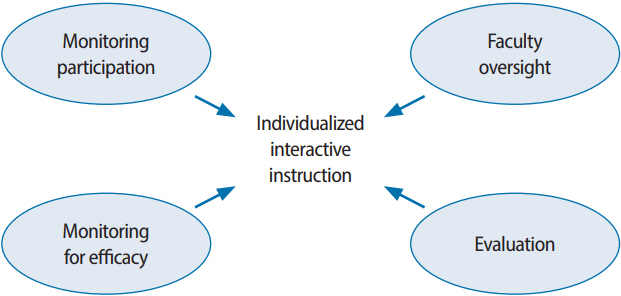J Educ Eval Health Prof.
2017;14:29. 10.3352/jeehp.2017.14.29.
Efficacy of an asynchronous electronic curriculum in emergency medicine education in the United States
- Affiliations
-
- 1Department of Emergency Medicine, Irvine School of Medicine, University of California, Orange, CA, USA. awray@uci.edu
- 2Irvine School of Medicine, University of California, Irvine, CA, USA.
- KMID: 2406692
- DOI: http://doi.org/10.3352/jeehp.2017.14.29
Abstract
- PURPOSE
The aim of this study was to measure the effect of an iPad-based asynchronous curriculum on emergency medicine resident performance on the in-training exam (ITE). We hypothesized that the implementation of an asynchronous curriculum (replacing 1 hour of weekly didactic time) would result in non-inferior ITE scores compared to the historical scores of residents who had participated in the traditional 5-hour weekly didactic curriculum.
METHODS
The study was a retrospective, non-inferiority study. conducted at the University of California, Irvine Emergency Medicine Residency Program. We compared ITE scores from 2012 and 2013, when there were 5 weekly hours of didactic content, with scores from 2014 and 2015, when 1 hour of conference was replaced with asynchro-nous content. Examination results were compared using a non-inferiority data analysis with a 10% margin of difference.
RESULTS
Using a non-inferiority test with a 95% confidence interval, there was no difference between the 2 groups (before and after implementation of asynchronous learning), as the confidence interval for the change of the ITE was −3.5 to 2.3 points, whereas the 10% non-inferiority margin was 7.8 points.
CONCLUSION
Replacing 1 hour of didactic conference with asynchronous learning showed no negative impact on resident ITE scores.
Keyword
MeSH Terms
Figure
Reference
-
References
1. Brydges R, Dubrowski A, Regehr G. A new concept of unsupervised learning: directed self-guided learning in the health professions. Acad Med. 2010; 85(10 Suppl):S49–S55. https://doi.org/10.1097/ACM.0b013e3181ed4c96.
Article2. Toohey SL, Wray A, Wiechmann W, Lin M, Boysen-Osborn M. Ten tips for engaging the millennial learner and moving an emergency medicine residency curriculum into the 21st century. West J Emerg Med. 2016; 17:337–343. https://doi.org/10.5811/westjem.2016.3.29863.
Article3. Burnette K, Ramundo M, Stevenson M, Beeson MS. Evaluation of a web-based asynchronous pediatric emergency medicine learning tool for residents and medical students. Acad Emerg Med. 2009; 16 Suppl 2:S46–S50. https://doi.org/10.1111/j.1553-2712.2009.00598.x.
Article4. Nothnagle M, Goldman R, Quirk M, Reis S. Promoting self-directed learning skills in residency: a case study in program development. Acad Med. 2010; 85:1874–1879. https://doi.org/10.1097/ACM.0b013e3181fa02a4.
Article5. Gottlieb M, Boysen-Osborn M, Chan TM, Krzyzaniak SM, Pineda N, Spector J, Sherbino J. Academic primer series: eight key papers about education theory. West J Emerg Med. 2017; 18:293–302. https://doi.org/10.5811/westjem.2016.11.32315.
Article6. Eva KW, Regehr G. “I’ll never play professional football” and other fallacies of self-assessment. J Contin Educ Health Prof. 2008; 28:14–19. https://doi.org/10.1002/chp.150.
Article7. Accreditation Council for Graduate Medical Education. ACGME Program requirements for graduate medical education in emergency medicine [Internet]. Chicago (IL): Accreditation Council for Graduate Medical Education;2017. [cited 2017 Oct 23]. Available from: https://www.acgme.org/Portals/0/PFAssets/ProgramRequirements/110_emergency_medicine_2017-07-01.pdf.8. Accreditation Council for Graduate Medical Education. Frequently asked questions: emergency medicine [Internet]. Chicago (IL): Accreditation Council for Graduate Medical Education;2017. [cited 2017 Oct 23]. Available from: https://www.acgme.org/Portals/0/PDFs/FAQ/110_emergency_medicine_FAQs_2017-07-01.pdf.9. Counselman FL, Babu K, Edens MA, Gorgas DL, Hobgood C, Marco CA, Katz E, Rodgers K, Stallings LA, Wadman MC; 2016 EM Model Review Task Force, Beeson MS, Keehbauch JN. The 2016 model of the clinical practice of emergency medicine. J Emerg Med. 2017; 52:846–849. https://doi.org/10.1016/j.jemermed.2017.01.040.
Article10. Schifferdecker KE, Berman NB, Fall LH, Fischer MR. Adoption of computer-assisted learning in medical education: the educators’ perspective. Med Educ. 2012; 46:1063–1073. https://doi.org/10.1111/j.1365-2923.2012.04350.x.
Article11. Young TP, Bailey CJ, Guptill M, Thorp AW, Thomas TL. The flipped classroom: a modality for mixed asynchronous and synchronous learning in a residency program. West J Emerg Med. 2014; 15:938–944. https://doi.org/10.5811/westjem.2014.10.23515.
Article12. Jordan J, Jalali A, Clarke S, Dyne P, Spector T, Coates W. Asynchronous vs didactic education: it’s too early to throw in the towel on tradition. BMC Med Educ. 2013; 13:105. https://doi.org/10.1186/1472-6920-13-105.
Article13. Chenkin J, Lee S, Huynh T, Bandiera G. Procedures can be learned on the Web: a randomized study of ultrasound-guided vascular access training. Acad Emerg Med. 2008; 15:949–954. https://doi.org/10.1111/j.1553-2712.2008.00231.x.
Article14. Knapp KE, Townsend NL, Hanley SP, Misra L, Mergens PA. Resident learning styles: are we maximizing learning opportunities for today’s resident learner? Open J Anesthesiol. 2015; 5:177–182. https://doi.org/10.4236/ojanes.2015.57032.
Article15. Cheng D. Board review course effect on resident in-training examination. Int J Emerg Med. 2008; 1:327–329. https://doi.org/10.1007/s12245-008-0068-5.
Article16. Gene Hern H Jr, Wills C, Alter H, Bowman SH, Katz E, Shayne P, Vahidnia F. Conference attendance does not correlate with emergency medicine residency in-training examination scores. Acad Emerg Med. 2009; 16 Suppl 2:S63–S66. https://doi.org/10.1111/j.1553-2712.2009.00596.x.
Article
- Full Text Links
- Actions
-
Cited
- CITED
-
- Close
- Share
- Similar articles
-
- An Analysis of Research on the Impact of School-Based Physical Education for Preventing Students' Obesity: Systematic Review and Meta Analysis
- Current Situation of Medical Ethics Education in the United States of America
- Text messaging versus email for emergency medicine residents’ knowledge retention: a pilot comparison in the United States
- Overseas Residency Training Systems and Implications for Korea
- Current Status of the Resident Education Program and the Necessity of a General Competency Curriculum


